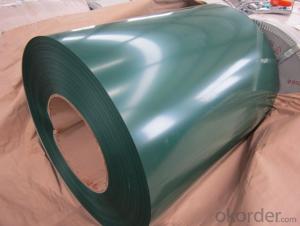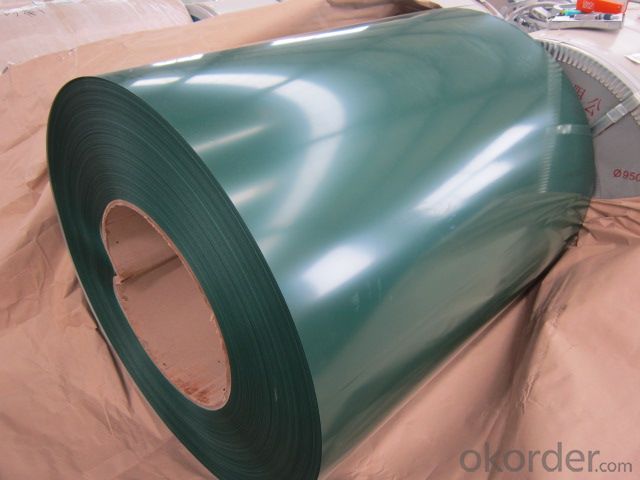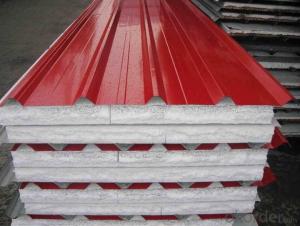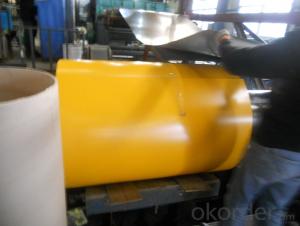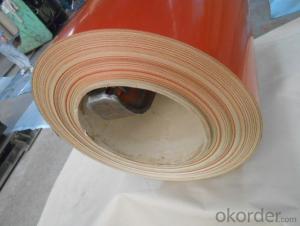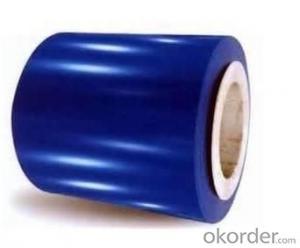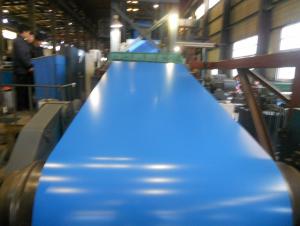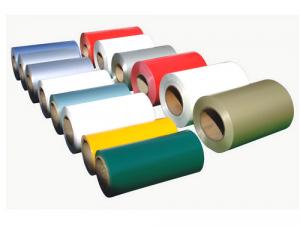PRE-PAINTED STEEL IN COILS
- Loading Port:
- China Main Port
- Payment Terms:
- TT OR LC
- Min Order Qty:
- -
- Supply Capability:
- -
OKorder Service Pledge
OKorder Financial Service
You Might Also Like
PRE-PAINTED STEEL IN COILS
ZINC COATING:G40
TOP COATING:5 MIC EPOXY+20 MIC PE, PROTECTION FILM
BACK COATING: 7 MIC EPOXY GREY
WEIGHT PER COIL:2-3 TONS COLOUR: RAL 9010 PURE WHITE
STANDARD:JIS G3312,CGCC
Package:seaorthy standard export
Applications:conditioning, micro-wave oven, bread maker,solar water heater,condencing apparatus,Blackboard, white board,chalkboard, hidden cell blackboard,bulletin board,Central heating slice, lampshade, chifforobe, desk, bed, locker, bookshelf,garbage can, billboard, typewriter, instrument panel, weight sensor, photographic equipment,coffin, fence, Prepainted Galvanized Steel Coil
Electrical appliance:Refrigerator, washer, switch cabinet, instrument cabinet, air
- Q: How are steel coils used in the manufacturing of shipping containers?
- Steel coils are used in the manufacturing of shipping containers to provide strength, durability, and structural integrity. These coils are processed and shaped into the necessary components, such as walls, floors, and roofs, which are then assembled to create a sturdy container. The steel coils also allow for easy transportation and stacking of the containers, ensuring safe and efficient shipping of goods worldwide.
- Q: I want to start getting throwing knives and i was wondering what material is best for quality, but still cheap. I also saw some 440 stainless steel knives that i liked and wanted to know if the material was good
- Good steel ain't cheap, cheap steel ain't good... If you're just starting out (practicing anyways), I would be less concerned about the material and more concerned about the style and shape of the blade to gain consistency in your technique... When you start getting proficient for competitions and such... then I'd start investigating steel grades... Anyways, here's a summary from the wiki: Type 440—a higher grade of cutlery steel, with more carbon, allowing for much better edge retention when properly heat-treated. It can be hardened to approximately Rockwell 58 hardness, making it one of the hardest stainless steels. Due to its toughness and relatively low cost, most display-only and replica swords or knives are made of 440 stainless. Available in four grades: 440A, 440B, 440C, and the uncommon 440F (free machinable). 440A, having the least amount of carbon in it, is the most stain-resistant; 440C, having the most, is the strongest and is usually considered more desirable in knifemaking than 440A, except for diving or other salt-water applications.
- Q: What are the dimensions of steel coils used in the automotive industry?
- The dimensions of steel coils used in the automotive industry can vary depending on the specific application, but common dimensions range from 0.5mm to 3mm in thickness and 600mm to 2000mm in width.
- Q: How are steel coils heat treated?
- Annealing is the method used to heat treat steel coils, resulting in improved mechanical properties and overall performance. To achieve this, the coils are heated to a specific temperature and slowly cooled down. This process relieves internal stresses within the steel and enhances its performance. To begin the heating process, the steel coils are raised to a critical temperature, typically between 800°C and 900°C, depending on the desired outcome. They are then maintained at this temperature for a specific period of time, allowing for the transformation of the steel's microstructure. Once the desired time has passed, the heated coils are carefully cooled down in a controlled manner. This gradual cooling process is crucial as it allows for a uniform and refined microstructure. It also helps prevent the formation of internal stresses that could weaken the steel. The annealing process can be conducted in various atmospheres, such as air, nitrogen, or hydrogen. The choice of atmosphere depends on the specific requirements and properties desired for the steel coils. For example, annealing in a protective atmosphere like nitrogen or hydrogen can prevent oxidation or decarburization of the steel surface. In conclusion, annealing is a crucial step in heat treating steel coils, resulting in improved mechanical properties, enhanced formability, and the desired characteristics for industrial applications.
- Q: What are the advantages of using steel coils over other materials?
- There are several advantages of using steel coils over other materials. Firstly, steel is highly durable and has a long lifespan, making it ideal for various applications. Secondly, steel coils have excellent strength and can withstand heavy loads and extreme weather conditions. Thirdly, steel is recyclable and environmentally friendly, ensuring sustainability. Additionally, steel coils provide superior corrosion resistance, reducing maintenance costs. Lastly, steel offers versatility in terms of customization, allowing for various shapes, sizes, and thicknesses to meet specific requirements.
- Q: How are steel coils used in the manufacturing of agricultural trailers?
- Steel coils are used in the manufacturing of agricultural trailers as they provide the necessary strength and durability required for heavy-duty applications. These coils are typically cut and shaped to form the framework and structural components of the trailer, ensuring it can withstand the demanding conditions of agricultural work. The coils may also be used to fabricate various parts, such as axles, suspensions, and hitches, further enhancing the trailer's robustness.
- Q: How do steel coils compare to aluminum coils?
- Steel coils and aluminum coils have several key differences that make them suitable for different applications. Firstly, steel coils are known for their strength and durability. They can withstand high temperatures and are less prone to damage compared to aluminum coils. This makes steel coils ideal for heavy-duty industrial applications that require robust materials, such as construction, automotive manufacturing, and oil and gas industries. Steel coils are also more resistant to corrosion, making them suitable for outdoor use in harsh environments. On the other hand, aluminum coils are lighter and have a higher strength-to-weight ratio compared to steel coils. This makes them perfect for industries where weight is a critical factor, such as aerospace and transportation. Aluminum coils are also more malleable, allowing for easier shaping and forming, which is advantageous in industries like packaging and consumer electronics. Moreover, aluminum coils have better thermal conductivity than steel coils, which makes them more efficient in heat transfer applications. This property is beneficial in industries like HVAC (heating, ventilation, and air conditioning) and refrigeration, where efficient heat exchange is crucial. In terms of cost, steel coils are generally more affordable compared to aluminum coils due to the lower cost of raw materials. However, aluminum coils can offer long-term cost savings as they require less maintenance and have a longer lifespan due to their resistance to corrosion. In conclusion, the choice between steel coils and aluminum coils depends on the specific requirements of the application. Steel coils are preferred for their strength, durability, and corrosion resistance, while aluminum coils excel in lightweight applications, heat transfer, and malleability.
- Q: If I wear a pair of thick wool socks, is walking around in the snow with steel-toed boots going to be a problem? I'm wondering if the steel will make my toes too cold.
- Dr. Martens makes a number of pairs of steel toed work boots. I have never owned a pair of their steel toes, but I have owned several pairs of their shoes and boots, the oldest of which is fifteen years old and still going strong. They take a couple of weeks to break in, but once they do, they are practically molded to your foot. They are more expensive, but they last a LONG time. Good Luck!
- Q: How do steel coil manufacturers contribute to local economies?
- Steel coil manufacturers contribute to local economies in several ways: 1. Job creation: Steel coil manufacturing facilities require a significant workforce to operate, including skilled workers, engineers, technicians, and support staff. By establishing and expanding manufacturing plants, steel coil manufacturers create employment opportunities for local residents. This leads to reduced unemployment rates and increased income levels, which in turn stimulates local spending and economic growth. 2. Supplier networks: Steel coil manufacturers rely on a wide range of suppliers for raw materials, equipment, and services. This creates a network of local businesses that benefit from the demand generated by manufacturing operations. These suppliers include steel producers, logistics companies, packaging providers, maintenance service providers, and many others. The presence of a steel coil manufacturer can stimulate the growth and development of these local businesses, enhancing the overall economic vitality of the region. 3. Secondary industries: The steel coil manufacturing industry acts as a catalyst for the development of secondary industries. These industries include steel fabrication, construction, automotive manufacturing, machinery production, and many others that rely on steel as a primary input. The presence of a steel coil manufacturer in a local economy can attract and support the growth of these industries, leading to increased economic activity and job opportunities. 4. Tax revenue: Steel coil manufacturers contribute to the local economy through the payment of various taxes. These include corporate income taxes, property taxes, sales taxes, and employment taxes. The tax revenue generated by these manufacturers is often significant and can be used by local governments to fund public infrastructure projects, education, healthcare services, and other essential services that benefit the community. 5. Economic multiplier effect: The economic impact of steel coil manufacturers extends beyond their direct operations. The presence of these manufacturers attracts other businesses and industries to the region, leading to a multiplier effect. For example, steel distributors, fabricators, and processors may establish operations nearby to take advantage of the proximity to the manufacturer. This creates a cluster of related industries that further contribute to the local economy, creating a self-sustaining cycle of economic growth and development. In summary, steel coil manufacturers contribute to local economies by creating jobs, supporting local suppliers, stimulating secondary industries, generating tax revenue, and triggering an economic multiplier effect. Their presence enhances the economic vitality of the region, leading to increased employment opportunities, income levels, and overall economic growth.
- Q: Question about steel type used in bridges.?
- It is used for other things besides bridges and that might be a bad use. Corten was used for very tall light standards in the Fort Worth Water Gardens with the clear understanding that it was to be kept dry. As time passed and personnel changed, somebody decided the round base with bolts sticking up was ugly and put dirt and plantings in the basin in the concrete holding the poles. The watering of the plants kept the rust going through the steel and one pole eventually fell, killing two people. The other light poles were removed.
Send your message to us
PRE-PAINTED STEEL IN COILS
- Loading Port:
- China Main Port
- Payment Terms:
- TT OR LC
- Min Order Qty:
- -
- Supply Capability:
- -
OKorder Service Pledge
OKorder Financial Service
Similar products
Hot products
Hot Searches
Related keywords
